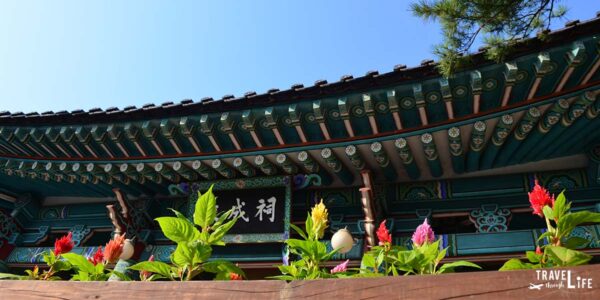Shin Saimdang possessed talents rarely seen in the world and hardly since her death in 16th century Korea, then the Joseon Dynasty. Yinsun (her real name) rose to fame as a writer, poet, and calligrapher but her paintings have reached legendary status. One story that’s been passed around involves a younger lady who’d spilled some tea on her skirt, which was borrowed and too expensive for her to replace. Shin learned of the woman’s plight and decided to help. You can read about Shin Saimdang’s story and more at her old home—Ojukheon House in Gangneung, Gangwon Province.
Ojukheon House
This travel guide is part of our series on South Korea Travel and East Asia Travel. It was originally created on November 28, 2014. It has been maintained and updated (as of December 28, 2018) to reflect current viewpoints and travel trends.
Shin Saimdang’s Painting
Continuing the story, Shin took the skirt and constructed a beautiful painting of leaves and grapes that attracted eager buyers at a nearby market. The woman was able to replace the skirt and even buy one of her own. It’s interesting that I’m walking around a place where such a talented person once lived. It’s not the original. Officials tore down Ojukheon House and replaced it with the current reconstruction.
The “Ideal” Woman
It’s yet another unfortunate truth found throughout South Korea—safety and/or aesthetics trump authenticity. Regardless, it’s important to remember the person and the fact that they were here, I say. Many circles refer to Shin Saimdang as the “ideal” woman, a loyal mother, and wife. It’s a characterization that drew intense criticism from Korean feminists when Shin was chosen to be one of the faces on South Korea’s monetary notes. But I still can’t get over the legend that surrounds her and the talent that came out of this home.
Yulgok
Her son was no normal man, either. Yi Yi or Yulgok rose to “boy prodigy” status at a very young age. I stare at his recreated living quarters and think about how important this household was to Korean society. But his story didn’t stop there.
Fighting for Change
Yulgok attempted to make big changes and implemented codes that would hopefully steer Joseon education in the right direction. It seems that the things he fought against (rote memorization, books over applied knowledge, etc.) are still an endemic problem in today’s Korea. I can vouch for that after years of teaching various levels of students in the country.
Aftermath
Nevertheless, his books and words on educational reform are preserved today. They’re hailed as a compass that the education should strive towards, yet it ignores. Of course, Shin Saimdang and her son Yulgok didn’t just fade away. They are two of the faces featured on Korea’s monetary notes, with Shin on the 50,000 won note while her son features on the 5,000. Perhaps people think more of the mother than the son after all?
Final Thoughts
What’s more interesting is that the people selected to appear come from a small time period and one far removed from modern Korea. Two closely connected figures remain important parts of Korea’s final dynastic period. The fact that they shared a home at Ojukheon House makes the relationship even more interesting.
What do you think of this important family’s story? Ever visited their home? Let me know in the comments section below:)
The Korean Spirit and Culture Project helped immensely with Shin Saimdang’s backstory. The Ehwa Voice also helped with understanding the dissent surrounding Shin’s fame and status as Korea’s ideal woman.


Yeah I love the interesting historical facts… And of course the pictures are amazing 🙂
Thanks!
I love learning new things about Korea, so thanks! I’ve been to Gangneung, but never here. Next time I’ll have to visit.
Thanks for sharing your photos- they’re beautiful!
So many beautiful photo and this was a good post~ Thumbs Up
Yeah, I read about all the money faces recently and I thought it was really interesting. Another thoughtful post with relevant historical facts! Thanks, Carl!
Thank you so much, Taylor! I hope you keep reading. Means a lot to hear from people such as yourself:)
1. I would never have thought to learn about the history of who is on the money in Korea! In fact, I have never thought of it in any country! And to be totally honest, I couldn’t tell you who is on some of the money in America! 2. This is a really cool story and makes me want to learn a lot more about Shim Saimdang. Keep exploring and doing research and teaching me about the history of Korea, please!
Hi Katie. Thank you so much for that kind comment. Don’t worry, I’m on it as far as researching parts of Korea and the history attached to them. I just hope you keep on reading:)
This truly is an excellent post. I love reading insightful and historical posts about Korean history. I knew some of these facts but didn’t know about the relationship between the two! Mother and son both featured, and his legacy for balanced and meaningful education. Well written and researched. I enjoyed this thoroughly.
Ryan
Thank you, Ryan. I hope you enjoyed reading and continue to come back. It’s good to have people like you in the same town as me. Take care.
I’ve never been to Gangneung as its just miles away from where I live,so I will live through you! Nice photos, I like how you added more photos than usual 😀 The history of Korean structures is always so intense. And I find it interesting how a lot of structures are destructed some how but almost always rebuild or reconstructed. Interesting post, thanks!
Thank you Rafiqua. Gangneung was such a brief stop for us, that I only remember this house. The East Coast has so much to offer that we had to move on from it. I’d definitely recommend a walk around Ojukheon when it warms up.
I have never wandered around Gangneung before. Nice of you to share this piece of Korean history. Great photos, too!
Thank you Alphonse. Gangneung was only a brief stop for us but as soon as I realized we were near such a famous house, it was a must-stop!
I really love how you organize all of your blog posts with headings. I know I’ve said this before, but the work you put into the accuracy of each post is so inspiring. I learn something new every time I read your posts!
Thank you Meaghan. I really appreciate your comments on my style. I’ve continued refining things from the very beginning. Some posts didn’t have that style before but as I keep editing my stuff, that’s changing:)
Wow! What interesting history surrounds this spot…Now I am all fired up to do some more reading into the background and legend surrounding Shin Saimdang and look into digging up some of her poetry. It is pretty cool that a female figure is depicted on the currency- and an artist at that! A definite rarity. I hadn’t yet taken the time to wrap my head around who from history appears on Korean money so thanks for that bit of info…Definitely sounds like a place I would like to visit.
Thank you Lara. I really am happy that you enjoyed reading this. It makes us consider what’s going on with the basic things in life, I guess. Money is something we take for granted and don’t really look into the backstory of it all. I hope you keep coming back for more. Take Care.
Awesome to learn about who is featured on the money! I knew about Sejong on the 10000 won note but didn’t know about these two. I think my students may have mentioned it before but I’m not sure. Anyways, it’s cool that they feature an artist rather than only political leaders like we do in the U.S.A.
Thanks for the comment, Matt. Yeah, it’s interesting to know that Korean politicos aren’t on all the money. I wonder who we’d put from the cultural sects in our country?
Good question! Maybe Hemingway? Definitely some rock star too but no idea who…
I bet lots of people would go for Springsteen. I could see him on a 50, lol.
It’s lovely to learn something new. I hadn’t considered who the people are on paper that I use everyday but rarely ever look at.
I have to say, it is a shame that so many temples, palaces etc… are reconstructed. Although the replicas are beautiful, it does seem a shame that the originals are lost forever.
Thanks for your comment. I do agree with you on the shame that these places are reconstructions. In some cases, it’s unavoidable though. Hopefully people can understand that and in other cases, avoid it.
Duke, your photography is beautiful. I haven’t been to a place in Korea with as much authenticity as you conveyed here, but I’m on the look out for the opportunity. Great background on the Won. 🙂
Thanks for the comment. I hope you find something special when visiting new places here. I really appreciate your kind thoughts. Take care.
I love stories about the Joseon Dynasty, I haven’t heard this one before! Thanks for sharing, and as always, stunning photos.
Thanks for stopping by and leaving a comment. I have more coming in the works. Maybe you’ll see one that piques your interest:)
Interesting history and yet a bit confusing that even though his teachings are preserves they aren’t observed. I can image that this poses a challenge for teachers! I appreciate the history and most especially the photos of Ojukheon and Gangneung
I first discovered his Yi YI’s paradoxical history when doing some research for a collab effort a few years back. Visiting his house rekindled my curiosity. I still can’t get my head around this, because the issue still persists here. How can you stare at someone who pointed out a better way and hail them as a savior, all the while ignore them? It just baffles me, to be honest. Thanks for the comment, Jacquie. Maybe this’d make a good “Where’s the Justice?”